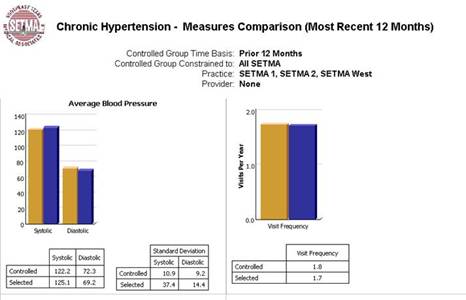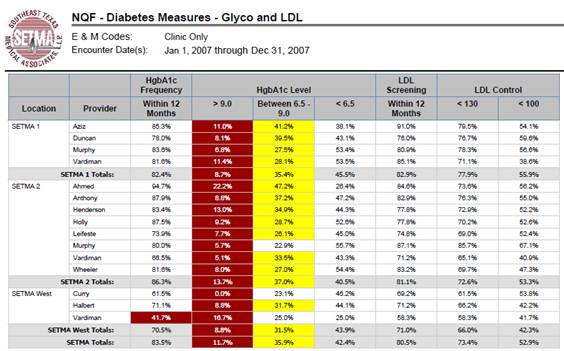|
(Author’s note -- Each year, a national organization accepts application for a prestigious award for healthcare quality. SETMA is applying for the 2012 award. This article is a shorter version of section two of six sections for the application.)
Section Two of the award application describes how dashboard information is shared with and used by clinical and administrative leaders and frontline caregivers to drive performance improvement. That starts with the SETMA Model of Care which includes five steps:
- The tracking by each provider on each patient of the providers’ performance on preventive and screening care and on quality standards for acute and chronic care, which occurs simultaneously with the performing of these services by the entire healthcare team, including the personal provider, nurse, clerk, management. The data aggregation occurs automatically at all points-of-care.
- The auditing of performance on the above standards is done on the practice, each clinic, or each provider. The focus of the audit is an individual patient, a unique population of patients, or a panel of patients. SETMA believes that this is what is missing from most quality improvement programs.
- The statistical analyzing of audit results to measure improvement by practice, by clinic, or by provider. This includes analysis for ethnic disparities, and other discriminators such as age, gender, payer class, socio-economic groupings, education, frequency of visit, frequency of testing, etc. This allows SETMA to look for leverage points through which to improve care and/or to design quality improvement initiatives.
- The public reporting by provider name of performance on hundreds of quality measures. This helps overcome “clinical inertia,” by pressuring all providers to improve; it also allows providers and patients to know what is expected of them. The disease management tools “plans of care” and the medical-home-coordination document summarize a patient’s state of care and encourage them to ask their provider for any preventive or screening care which has not been provided.
- The design of Quality Assessment and Permanence Improvement Initiatives - SETMA’s 2011 initiatives involved the elimination of all ethnic disparities of care for diabetes, hypertension and dyslipidemia, and reducing hospital preventable readmissions.
The key to this Model is the real-time ability of providers to measure their own performance at the point-of-care. This is done with multiple displays of quality metric sets, with real-time aggregation of performance incidental to excellent care.
The providers’ compliance with these measures is color coded for quick reference: “Black” means that the measure applies to the patient and has been done; “Red” applies and has not been done; “Gray” does not apply. The “view” button allows the provider to review the content of the metric and the patient’s results in detail. Real-time auditing of performance by providers at the point-of-care provides the most leverage for performance improvement.
Dashboards
The following are examples of auditing dashboards for provider performance analysis. Note: The columns in gold are the patients who are treated to goal and those in purple are the patients not to goal.


SETMA is able to look at differences between the care of patients who are treated to goal and those who are not. Patients can be compared as to socio-economic characteristics, ethnicity, frequency of evaluation by visits, and by laboratory analysis, numbers of medications, payer class, cultural, financial and other barriers to care, gender and other differences. This analysis can suggest ways in which to modify care in order to get all patients to goal.
 
It is also possible for us to present over-time patient results comparing different providers and different clinics with one another:

SETMA’s provider performance is benchmarked against published, evidence-based, national standards of care. Because SETMA has deployed a robust Business Intelligence solution for data auditing and analytics, and because we have bought multiple licenses, practice leadership, informatics staff and healthcare providers can review performance ourcomes. SETMA also has monthly peer-review sessions with all providers. The clinic is closed for a morning, and performance on Quality Metrics, patient satisfaction and gaps-in-care are discussed openly among all providers. Collegial relationships and organizational-cultural commitment to excellence make it possible for SETMA to be specific about needs for improvement in these monthly meetings.
The following is an example of a dashboard which is color coded: “white” is to goal, “yellow” needs improvement, and “red” is unacceptable. The first display is of NQF Diabetes Metrics on HbA1c and LDL:

When the 2007 results are compared with the January 1st to December 31, 2011, it is possible to see that the quality standards are still being met. The HbA1c percentage above 9.0% is shown in red as SETMA “standard” is that this value should be zero, but the NCQA benchmark is that it be less than 15% of the patients being treated for diabetes.

Special Dashboards - NCQA Diabetes Recognition Program Audit

Specific dashboards, such as the one above, have also been developed for programs such as the NCQA Diabetes Recognition Program. All SETMA clinics and providers qualified for this recognition in 2010. Quarterly and annually, we now measure this standard so as to make sure that we continue to improve. As can be seen below, the dashboard gives the metric, the benchmark, the provider’s performance and the aggregate score required for recognition. This material is given to the provider and it is posted on our website under Public Reporting, NCQA Diabetes Recognition Program Audit. Because all deficiencies in care are displayed in “red,” SETMA providers have developed their own commitment to “get the RED out.”
|